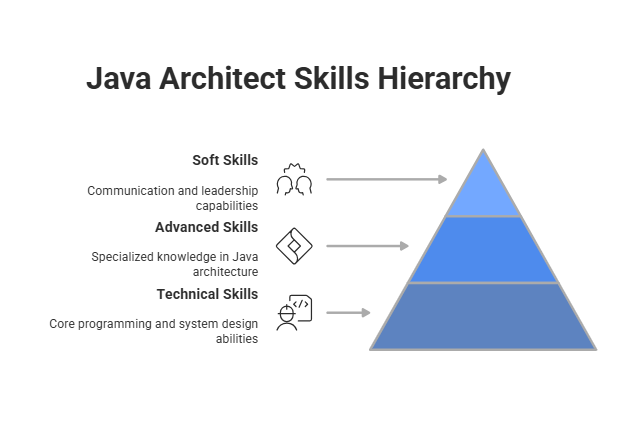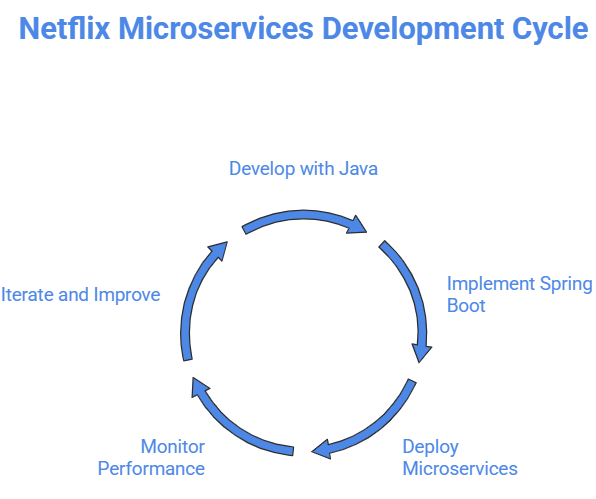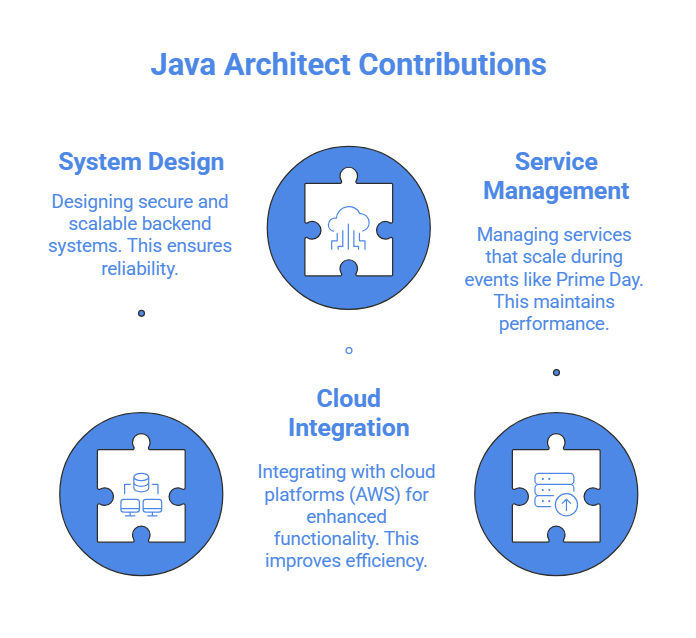06
DecTop Java Architect Skills and Responsibilities to Master in 2025
Java Architect Skills refer to the specialized technical and soft skills required to design, build, and manage complex Java-based software systems. These skills include a deep understanding of Java programming, architecture patterns, and the software development lifecycle, along with strong communication, problem-solving, and leadership abilities. A Java architect utilises these skills to create scalable, secure, and maintainable software solutions that align with business objectives.
In this Java tutorial, we will explore the key Java Architecture Skills, including technical design, use of frameworks, system scalability, database handling, security best practices, and essential soft skills.
What Does a Java Architect Do?
Java Architect skills are the key technical and leadership abilities required to design, develop, and manage scalable Java-based software systems. These skills include expertise in Java programming, Spring framework, microservices architecture, cloud platforms (like AWS or Azure), and DevOps tools. A Java Architect must also possess strong problem-solving, communication, and team leadership skills to ensure successful project delivery. These skills play a crucial role in building high-performance, secure, and future-ready enterprise applications.

Types of Java Architect Skills
To build strong and scalable software systems, a Java Architect must have a combination of different skill types. These can be grouped into three major categories: technical skills, architectural design skills, and soft skills. Each plays a unique role in ensuring the success of software projects.
1. Core Java: Building a Strong Foundation
Core Java refers to the fundamental aspects of the Java programming language that every developer must master. It includes the basic syntax, object-oriented principles, and standard libraries used to build robust and efficient Java applications.
Expanded insight: A Java Architect must deeply understand Core Java as it is used in every Java-based application—from small utilities to large-scale enterprise software. Knowing how the Java Virtual Machine (JVM) works, how memory is managed, and how the object model functions gives architects an edge in optimizing applications.
Examples-
- Designing reusable classes and interfaces.
- Understanding memory leaks and optimizing garbage collection.
- Debugging low-level application issues.
Why It Matters:- Without a deep foundation in Core Java, it’s difficult to make informed decisions on frameworks, performance tuning, or system structure.
2. Advanced Java: Unlocking Expert-Level Features
Advanced Java includes high-level features and APIs that support complex, large-scale, and performance-critical applications. It enables architects to write optimized, scalable, and maintainable code using modern Java techniques.
Expanded Insight: In a distributed or high-concurrency system, an architect must know how to manage threads, reduce contention, and use asynchronous programming. Java 8 and newer introduce modern paradigms like functional programming, which make code more concise and readable.
Examples-
- Building multi-threaded applications (e.g., banking systems).
- Using streams to process large data collections efficiently.
- Applying functional programming for cleaner APIs.
Why This Skill Is Important:
- Supports building high-performance, real-time systems.
- Enhances code efficiency with Streams and functional programming.
- Helps architects modernize legacy systems effectively.
3. Spring Framework: Mastering Enterprise Applications
The Spring Framework is a comprehensive, lightweight solution for building Java applications. It provides infrastructure support for developing secure, testable, and loosely coupled enterprise applications.
Expanded Insight: Spring Boot reduces boilerplate and enables rapid development, while Spring Security ensures enterprise-grade protection. Spring Cloud helps in building resilient microservices with tools like Config Server, Netflix Eureka, and Circuit Breaker.
Examples-
- Building REST APIs with Spring Boot.
- Implementing JWT authentication using Spring Security.
- Using Spring Data JPA for ORM and repository layers.
Why This Skill Is Important:
- Most enterprise Java applications rely on Spring.
- Reduces development time and simplifies configurations.
- Supports security, data access, and microservices.
4. Microservices Architecture: Designing Scalable Systems
Microservices architecture is a software design approach where an application is structured as a collection of small, autonomous services. Each service handles a specific business function and communicates with others through APIs.34
Expanded Insight: Java Architects must design services around business capabilities. This includes choosing communication protocols (REST, gRPC), managing service discovery, and handling failures gracefully.
Examples-
- Designing domain-driven microservices (e.g., user-service, order-service).
- Implementing API gateways (like Spring Cloud Gateway).
- Managing data consistency using event-driven architecture.
Why This Skill Is Important:
- Enables agile and scalable software development.
- Promotes faster deployment and fault isolation.
- Powers modern cloud-native applications.
5. System Design & Architecture Patterns: Crafting Robust Solutions
System design involves creating the high-level structure of software systems, while architecture patterns are proven templates that guide this design. Together, they help in planning scalable, robust, and maintainable solutions.
Expanded Insight: Architects must balance trade-offs between performance, scalability, and maintainability. They often apply layered, hexagonal, or event-driven patterns to match system needs.
Examples:
- Choosing between synchronous vs. asynchronous communication.
- Using a layered architecture to separate concerns.
- Designing fault-tolerant systems with retry mechanisms.
Why This Skill Is Important:
- Essential for creating high-performing enterprise systems.
- Helps manage complexity in large-scale applications.
- Guides decision-making around system structure and components.
6. Design Patterns: Best Practices for Code Reusability
Design patterns are general, reusable solutions to common software design problems. They represent best practices that help in writing flexible and maintainable code.
Expanded Insight: A Java Architect frequently uses patterns to solve architectural problems consistently. For example, a Factory pattern can be used to abstract object creation, and a Proxy can help with lazy loading or access control.
Examples-
- Applying Singleton for shared services like logging.
- Using Strategy for implementing multiple algorithms dynamically.
- Refactoring legacy code to apply cleaner design principles.
Why This Skill Is Important:
- Promotes standardization and code reusability.
- Reduces development effort by solving recurring problems.
- Helps maintain consistency across the development team.
7. Database Management: Optimizing Data Handling
Database management involves designing, integrating, and maintaining data systems that support application operations. It includes working with both relational and NoSQL databases.
Expanded Insight: Java Architects must not only write optimized SQL queries but also model data structures that support business logic and performance requirements. They should be fluent in relational databases (like MySQL, PostgreSQL) and NoSQL databases (like MongoDB, Redis) to cater to various data needs.
Examples-
- Designing entity-relationship models for normalized database structures.
- Implementing database indexing and caching for performance.
- Managing distributed transactions in microservices environments.
Why This Skill Is Important:
- Ensures efficient data storage, retrieval, and integrity.
- Supports both structured and unstructured data handling.
- Essential for back-end scalability and performance.
8. DevOps & CI/CD: Streamlining Development Pipelines
DevOps is a cultural and technical practice that bridges software development and IT operations. Continuous Integration/Continuous Deployment (CI/CD) automates the build, test, and deployment processes.
Expanded Insight: A Java Architect should know how to set up CI/CD pipelines, automate deployments using tools like Jenkins, Docker, and Kubernetes, and manage environments for staging and production. This reduces the feedback loop and ensures faster and safer releases.
Examples-
- Setting up GitHub Actions or Jenkins for automated builds and deployments.
- Containerizing Java apps with Docker and orchestrating with Kubernetes.
- Implementing rollback strategies in deployment processes.
Why This Skill Is Important:
- Speeds up delivery cycles with fewer bugs.
- Improves collaboration across development and operations teams.
- Reduces deployment risk through automation.
9. Cloud Computing: Leveraging AWS, Azure, and More
Cloud computing enables the delivery of computing services—servers, storage, databases, networking, and software—over the internet, allowing applications to be deployed globally and scaled dynamically.
Expanded Insight: Java Architects should be able to design cloud-native applications that leverage services from AWS, Azure, or GCP. This includes understanding autoscaling, high availability, monitoring, and serverless options like AWS Lambda.
Examples-
- Deploying Java applications using Docker on AWS EC2 instances.
- Using AWS S3 for storing application assets and backups.
- Building serverless Java functions with AWS Lambda or GCP Cloud Functions.
Why This Skill Is Important:
- Makes applications globally available and highly scalable.
- Reduces infrastructure costs and manual management.
- Enables serverless and container-based architectures.
10. Security Practices: Safeguarding Java Applications
Security practices involve implementing measures to protect applications from data breaches, unauthorized access, and other threats. Security is a non-negotiable part of modern software architecture.
Expanded Insight: Java Architects must implement security at every layer—from authentication and authorization to encrypted data transmission and secure coding. Following OWASP guidelines and integrating security testing into the SDLC is crucial.
Examples:
- Applying role-based access control (RBAC) and JWT authentication.
- Preventing threats like SQL Injection, Cross-Site Scripting (XSS), and CSRF.
- Using HTTPS, secure headers, and encrypted storage for sensitive data.
Why This Skill Is Important:
- Protects sensitive data and ensures compliance (e.g., GDPR).
- Prevents application vulnerabilities and exploits.
- Builds trust among users and clients.
11. Testing & Quality Assurance: Ensuring Reliable Code
Testing and QA are practices to ensure that the software meets quality standards, works as intended, and remains stable after changes.
Expanded Insight: Java Architects must design systems that are testable and support automation. They should promote Test-Driven Development (TDD), Behavior-Driven Development (BDD), and integrate unit, integration, and performance testing into CI/CD pipelines.
Examples:
- Writing unit tests using JUnit and integration tests with TestNG.
- Mocking dependencies with Mockito for isolated testing.
- Enforcing code coverage and quality standards using SonarQube.
Why This Skill Is Important:
- Reduces bugs and improves software reliability.
- Supports continuous delivery through automated testing.
- Encourages cleaner and test-driven development.
12. System Integration: Connecting Complex Ecosystems
System integration connects various software components or services to work together as a unified system. It is critical for applications that involve multiple subsystems or external services.
Expanded Insight: In large distributed systems, integration is key. Java Architects must manage communication between microservices, integrate third-party APIs, and use messaging systems like Kafka for asynchronous processing.
Examples:
- Creating RESTful clients to consume external APIs.
- Using Kafka for event-driven communication between services.
- Managing XML/JSON transformations and API gateways.
Why This Skill Is Important:
- Ensures smooth communication between services or third-party APIs.
- Enables automation across different platforms or modules.
- Critical in distributed or enterprise applications.
13. Soft Skills: Leading Teams and Communicating Effectively
Soft skills are interpersonal abilities that enable collaboration, leadership, and communication—complementing technical expertise.
Expanded Insight: As team leads and project influencers, Java Architects must communicate clearly, manage stakeholders, resolve conflicts, and mentor junior developers. These skills directly impact the success of technical and business goals.
Examples:
- Leading architectural discussions with stakeholders.
- Writing technical documentation and proposals.
- Mentoring team members and managing cross-functional teams.
Why This Skill Is Important:
- Helps lead teams and resolve conflicts effectively.
- Improves communication with stakeholders and clients.
- Boosts productivity through mentorship and collaboration.
Why are Java Architect Skills essential in today's software industry?
In today’s fast-paced and competitive software industry, Java Architect skills are more important than ever. As applications become larger, more complex, and user-focused, businesses need professionals who can not only code but also design smart, scalable, and secure systems. This is where Java Architects make a big impact.
1. They Provide the Foundation for Scalable Systems- Java Architects design the overall structure of software applications, ensuring that the system can handle high traffic, large amounts of data, and future updates without breaking down. This is especially important for growing businesses and enterprise applications.
2. They Ensure Security and Stability- Security threats are a major concern today. Java Architects use best practices like secure coding, authentication protocols (OAuth2, JWT), and architecture-based defenses to build systems that protect user data and prevent attacks.
3. They Align Technology with Business Goals- A skilled Java Architect understands both technical needs and business objectives. They help bridge the gap between what the business wants and how it should be built — ensuring the final product meets expectations in performance, cost, and functionality.
4. They Lead and Guide Development Teams- Java Architects take leadership roles in software projects. They guide developers, review code, and make key decisions that affect the success of the project. Their experience helps teams avoid costly mistakes and build cleaner, more maintainable codebases.
5. They Drive Cloud and Modern Architecture Adoption- Most modern systems run on the cloud and follow architectures like microservices. Java Architects play a key role in designing these systems using tools like Spring Boot, Docker, and cloud platforms such as AWS or Azure.
How to develop Java Architect Skills?
Becoming a Java Architect is a gradual journey that involves mastering Java, understanding system design, and building strong communication and leadership skills. Here's how you can effectively develop these skills:
1. Get Strong in Core Java- Start by learning Java really well. Understand the basics like:
- How Java code works (OOP concepts like classes, objects, inheritance)
- How to handle errors (exception handling)
- How Java runs programs (JVM, memory, threads)
2. Work with Real Tools and Frameworks- Next, learn the tools used in real projects:
- Spring Boot (for creating web apps and services)
- Hibernate or JPA (for working with databases)
- Git, Maven, and other tools used in daily development
3. Understand How to Design Big Systems- You need to learn how large apps are built and structured. Start with:
- What is microservices or monolithic architecture?
- What are design patterns (like Singleton or Factory)?
- How to plan for speed, security, and future growth?
4. Learn About Cloud and Deployment Most modern apps run on the cloud (like AWS or Azure). You should also know:
- How to use Docker (to package apps)
- How apps are tested and deployed automatically using CI/CD tools
5. Improve Your Communication and Leadership
- Technical knowledge is not enough. You also need to:
- Talk clearly with your team and clients
- Help junior developers
- Make smart decisions under pressure
Advantages of Java Architect Skills
- Design Better Software Systems- Java Architect skills help you build applications that are well-structured, efficient, and easy to maintain. You can plan systems that are scalable and perform well, even as user demand grows.
- Make Smart Technology Decisions- With strong architectural knowledge, you can choose the right tools, frameworks, and design patterns for a project—saving time, effort, and money in the long run.
- Build Secure and Scalable Applications- Java Architects know how to design systems that protect user data and handle large traffic. This is critical for enterprise software, banking apps, e-commerce platforms, and more.
- Bridge the Gap Between Business and Technology- Java Architects understand both technical and business needs. This helps you turn business goals into technical solutions that actually work and deliver value.
- Increase Career Growth Opportunities- Having Java Architect skills opens up high-level roles such as Technical Lead, Solutions Architect, or Enterprise Architect, and often leads to higher salaries and leadership positions.
- Adapt to Modern Tech Trends- Java Architects are usually the first to adopt trends like microservices, cloud computing, and DevOps—keeping your knowledge relevant and future-proof.
Real-world use cases
1. Netflix – Microservices with Spring Boot and Java

Netflix uses Java with Spring Boot to build its massive microservices architecture.
Java Architects at Netflix design:
- Independent microservices for streaming, billing, and recommendations
- Scalable systems that handle millions of concurrent users
- High-availability and fault-tolerant systems
Key Skills Used: Microservices design, Spring Boot, REST APIs, scalability, resilience
2. Amazon – Scalable E-Commerce Infrastructure

Amazon uses Java to power various services including product catalogs, inventory, and order processing.
Java Architects contribute by:
- Designing secure and scalable backend systems
- Integrating with cloud platforms (AWS)
- Managing services that scale during events like Prime Day
Key Skills Used: AWS cloud architecture, Java APIs, secure coding, high-traffic system design
Conclusion
Mastering Java Architect skills is key to designing scalable, secure, and high-performance Java applications. In today’s competitive software industry, these skills empower developers to lead projects, solve complex challenges, and build modern enterprise solutions using Java, Spring Boot, and cloud technologies. If you want to be a certified Java professional, go for Scholarhat's Java Solution Architect Certification Training.





